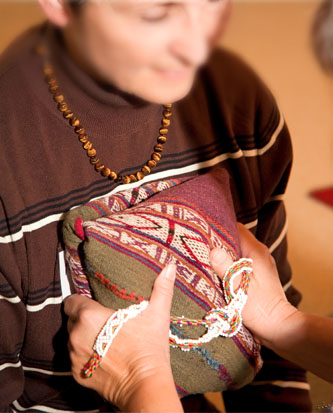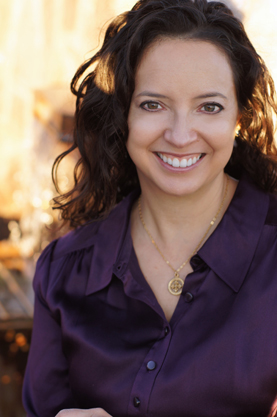 The word mesa means table in Spanish but it also means high plateau, the place where the shaman goes to meet the spirits.
The word mesa means table in Spanish but it also means high plateau, the place where the shaman goes to meet the spirits.
A shaman’s mesa is a portable altar (where he goes to meet the spirits) or medicine bundle used for healing, ceremony, prayer and divination. The contents of a mesa vary from shaman to shaman, but generally include healing stones and other artifacts representing elements of their personal healing journey.
Students at the Light Body School earn 13 stones as they participate in rites and initiations during the course of their training. Each stone, known as a khuya, represents a wound that has been transformed into a source of wisdom and courage. Later, in their own practice, they use these khuyas in energy medicine sessions for helping others.
A mesa may also contain special gifts and power objects that assist the shaman in communicating with spirits, warding off negative energies, and diagnosing ailments. All these items are wrapped in a cloth or bag (often a colorful textile known as a Mastana). Many shamans carry their mesa with them wherever they go.
Many years ago in Peru (as described in my book, Healing States), I learned that the mesa is divided into three areas: the campo ganadero (field of the dark) on the left; the campo justiciero (field of the light, or justice) on the right; and the campo medio or neutral field, a place between the fields of light and dark. My shaman guide, don Eduardo, explained that these forces are neither positive nor negative, but what human beings choose to do with them makes them good or evil.
His personal mesa included (among many other objects) a stone shaped like a serpent (symbolizing the connection to the earth), the foreleg of a deer (used to escape from dangerous situations or to “blow” people away from certain power places), a thousand-year-old sling he used to strike blows against negative entities, a rock shaped like a battle-axe (for defense against enemies), an ancient ceramic foot (used to track people lost in the forest or mountains), a clay bat (representing the forces of the night as well as human fears) and a number of ceramic objects and ritual stones representing organs in the body, used to diagnose ailments.
The middle (neutral) field of his mesa was dominated by an image of the sun, and below that a wooden statue of St. Cyprian, the Christian martyr (whom don Eduardo claimed was the first shaman), and a large key (to the doorway between the fields of light and dark). Below the key were two crystals that when struck together produced flying sparks used to ward off negative influences.
On the right side (the field of the light) were a collection of crystals and images of several Christian saints that he regarded as powerful beings of light helpful in diagnosing illness. Below the saints were two seashells used to drink a mix of alcohol, tobacco and sweet oils when making an offer to Mother Earth. He also had a number of perfumes, sweet oils and water to cleanse persons that were to receive healing.
Directly before the mesa, the shaman’s power staffs and swords were placed upright in the earth. The staff of the serpent was placed between the fields of the light and of the dark to represent balance and the bringing together of the earth and heavenly energies.
On the left side (field of the dark) the staff of the maiden symbolized the medical flowers and herbs. Next to it, an owl represented the ancient burial places and the forces of the night. And last, at the far right, was the staff of Lucifer, representing all aspects of evil – frequently the cause of disease.
The shaman’s mesa can be found in one form or another among many native healers in the Americas. The meaning of the symbols vary from culture to culture, as do specific steps in the ceremony. However, all of the mesa rituals – whether in North or South America – serve as a reminder that the forces of nature and of the human psyche can be worked with when represented as symbols and objects of power.
.








